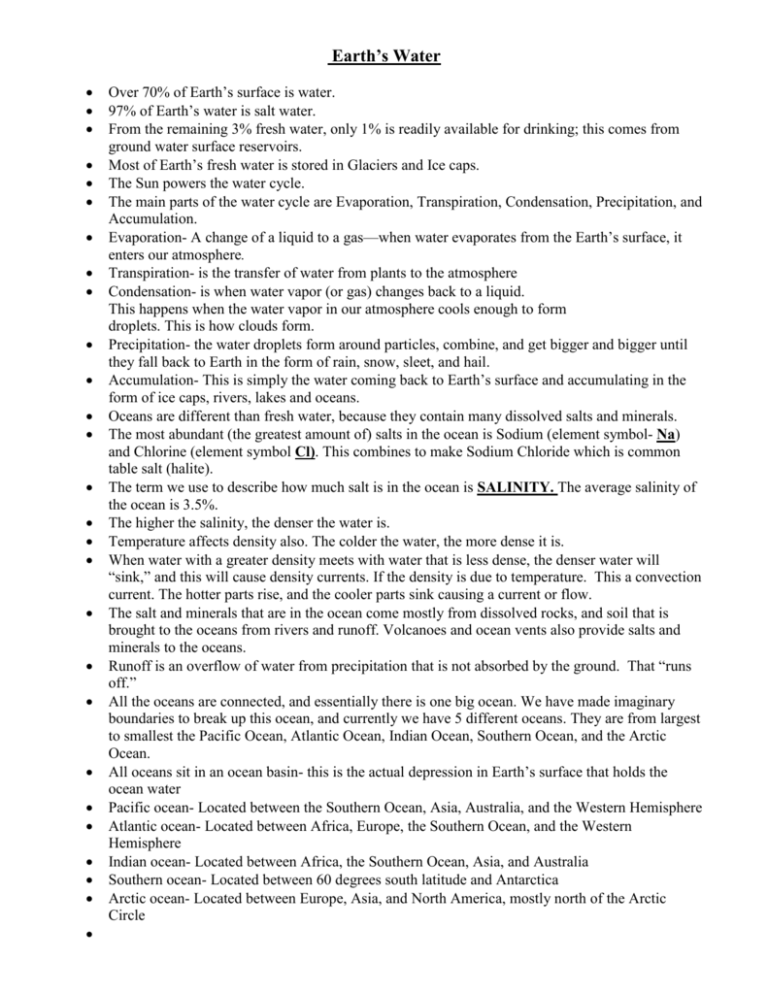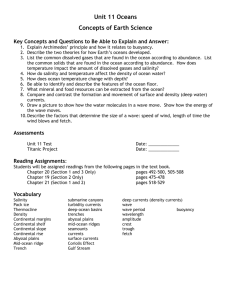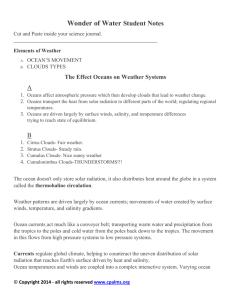Water Supplemental notes
advertisement

Earth’s Water Over 70% of Earth’s surface is water. 97% of Earth’s water is salt water. From the remaining 3% fresh water, only 1% is readily available for drinking; this comes from ground water surface reservoirs. Most of Earth’s fresh water is stored in Glaciers and Ice caps. The Sun powers the water cycle. The main parts of the water cycle are Evaporation, Transpiration, Condensation, Precipitation, and Accumulation. Evaporation- A change of a liquid to a gas—when water evaporates from the Earth’s surface, it enters our atmosphere. Transpiration- is the transfer of water from plants to the atmosphere Condensation- is when water vapor (or gas) changes back to a liquid. This happens when the water vapor in our atmosphere cools enough to form droplets. This is how clouds form. Precipitation- the water droplets form around particles, combine, and get bigger and bigger until they fall back to Earth in the form of rain, snow, sleet, and hail. Accumulation- This is simply the water coming back to Earth’s surface and accumulating in the form of ice caps, rivers, lakes and oceans. Oceans are different than fresh water, because they contain many dissolved salts and minerals. The most abundant (the greatest amount of) salts in the ocean is Sodium (element symbol- Na) and Chlorine (element symbol Cl). This combines to make Sodium Chloride which is common table salt (halite). The term we use to describe how much salt is in the ocean is SALINITY. The average salinity of the ocean is 3.5%. The higher the salinity, the denser the water is. Temperature affects density also. The colder the water, the more dense it is. When water with a greater density meets with water that is less dense, the denser water will “sink,” and this will cause density currents. If the density is due to temperature. This a convection current. The hotter parts rise, and the cooler parts sink causing a current or flow. The salt and minerals that are in the ocean come mostly from dissolved rocks, and soil that is brought to the oceans from rivers and runoff. Volcanoes and ocean vents also provide salts and minerals to the oceans. Runoff is an overflow of water from precipitation that is not absorbed by the ground. That “runs off.” All the oceans are connected, and essentially there is one big ocean. We have made imaginary boundaries to break up this ocean, and currently we have 5 different oceans. They are from largest to smallest the Pacific Ocean, Atlantic Ocean, Indian Ocean, Southern Ocean, and the Arctic Ocean. All oceans sit in an ocean basin- this is the actual depression in Earth’s surface that holds the ocean water Pacific ocean- Located between the Southern Ocean, Asia, Australia, and the Western Hemisphere Atlantic ocean- Located between Africa, Europe, the Southern Ocean, and the Western Hemisphere Indian ocean- Located between Africa, the Southern Ocean, Asia, and Australia Southern ocean- Located between 60 degrees south latitude and Antarctica Arctic ocean- Located between Europe, Asia, and North America, mostly north of the Arctic Circle Surface waves are caused by wind. The stronger the wind is and the longer it lasts, the higher the surface wave. The Gulf Stream is one of the most famous surface currents. Sailors have been using its surface current for many years to speed up their travel time. It exists because of the winds that blow in regular directions. It brings warm water from the Gulf of Mexico to the Northeastern U.S. and Western Europe. Waves are a form of energy that travels through water. The water particles move in circular motions but do not actually move forward, instead the energy is moving forward. (If you were to watch something floating in the ocean, it will remain almost in the exact same spot as a wave goes by). Breaker: a wave at the beach crashes into shore, because the shore that it is moving past slows the bottom portion of the wave, and allows the top to continue past it or “break”. The main parts of a wave are the wavelength, the crest, the trough, and the wave height. Trough- the lowest part of the wave. Crest- the highest part of the wave. Wavelength- the horizontal distance between the crests or the troughs. Wave height- the vertical distance between crest and trough. In the picture above, A is the wave height, B is the trough, C is the crest, and D is the wavelength. Density currents are formed when denser water sinks below less dense water. Temperature and salinity affect the density of water, thus causing currents Upwelling- circulation in the ocean that brings deep cold water to the surface. This is caused by winds pushing the top levels of warm water away and allowing the colder water to rise and fill the area. Many nutrients come from the deeper waters, and this brings more fish to the area. Coriolis Effect: the winds and ocean currents are both affected by the rotation of the Earth. As the Earth spins, it causes the winds and currents to bend in a more circular path depending on which part of the earth it is on (Northern, or Southern hemisphere). In the Northern Hemisphere (above the equator), the Coriolis effect will cause wind and currents to turn clockwise. In the Southern Hemisphere below the equator, the Coriolis Effect will cause wind and currents to turn counter-clockwise.








